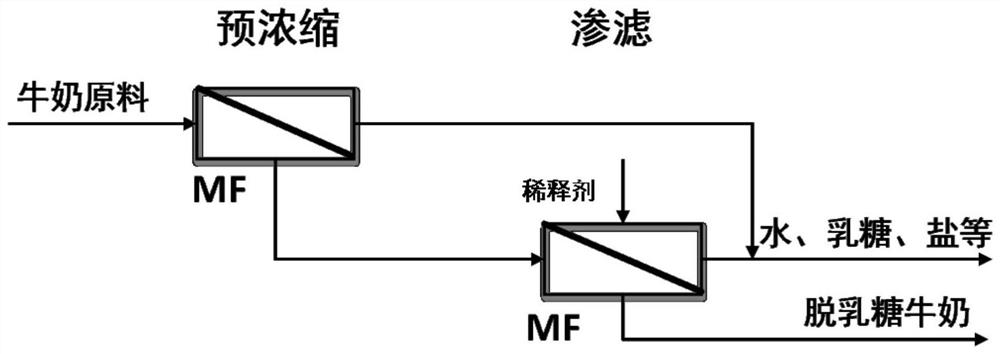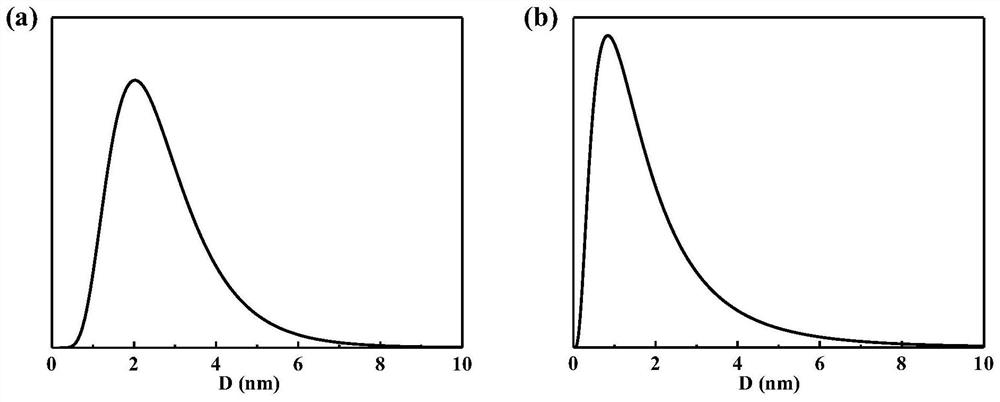Process for removing lactose in milk
A technology for delactose and milk, applied in the field of membrane separation, can solve the problems of low protein/lactose separation factor and low flux, and achieve the effects of strong anti-biological pollution, high nutritional value, and high-temperature disinfection alleviation.
- Summary
- Abstract
- Description
- Claims
- Application Information
AI Technical Summary
Problems solved by technology
Method used
Image
Examples
Embodiment 1
[0053] This example is used to compare the treatment effects of three different ceramic membranes on milk lactose. The three ceramic membranes used in this example are: Al with a pore size of ~5nm 2 o 3 and ZrO 2 Ultrafiltration membranes and Al with a pore size of ~100nm 2 o 3 microfiltration membrane.
[0054] Al in this patent 2 o 3 The number of pores in the ultrafiltration membrane within the pore diameter range of 1.3-4nm accounts for more than 80%.
[0055] ZrO in this patent 2 The number of pores in the ultrafiltration membrane in the range of 0.2-3nm pore diameter accounts for more than 80%.
[0056] The microfiltration membrane in this patent has more than 99% of the pores in the 94-104nm pore diameter range.
[0057] Put 10kg of skimmed milk raw material into the raw material tank, and use the above three ceramic membranes for pre-concentration, the pre-concentration factor is 2, the operating pressure is 2bar, the temperature is 30°C, and the membrane surf...
Embodiment 2
[0061] Add 10kg of skimmed milk raw material into the raw material tank, use 50nm ceramic microfiltration membrane for pre-concentration, the pre-concentration factor is 2, the operating pressure is 2bar, the temperature is 50°C, and the membrane surface flow rate is 6.5m·s -1 , to obtain 5kg of the first concentrated solution containing protein, calcium, part of lactose and 5kg of the first permeate containing lactose, small molecule vitamins, etc.; the first concentrated solution is carried out to constant volume intermittent feeding diafiltration, the operating pressure is 5bar, the temperature at 50°C, the flow velocity at the membrane surface is 6.5m·s -1 , first add 1 kg of water to the concentrated side, then concentrate the raw material side to 5 kg, perform the first diafiltration, repeat 9 times of diafiltration to obtain 5 kg of the second concentrate containing concentrated protein and calcium and 9 kg of lactose and small molecule vitamins The second permeate and ...
Embodiment 3
[0063] Add 10kg of skimmed milk raw material into the raw material tank, use 50nm ceramic microfiltration membrane for pre-concentration, the pre-concentration factor is 2, the operating pressure is 2bar, the temperature is 50°C, and the membrane surface flow rate is 6.5m·s -1 , to obtain 5kg of the first concentrated solution containing protein, calcium, part of lactose and 5kg of the first permeate containing lactose, small molecule vitamins, etc.; the first concentrated solution is carried out to constant volume intermittent feeding diafiltration, the operating pressure is 5bar, the temperature at 50°C, the flow velocity at the membrane surface is 6.5m·s -1 , first add 1 kg of water to the concentrated side, then concentrate the raw material side to 5 kg, perform the first diafiltration, and repeat the 2 times of diafiltration to obtain 5 kg of the second concentrate containing concentrated protein and calcium and 2 kg of lactose and small molecule vitamins. The second perm...
PUM
| Property | Measurement | Unit |
|---|---|---|
| Average pore size range | aaaaa | aaaaa |
| Aperture | aaaaa | aaaaa |
| Aperture | aaaaa | aaaaa |
Abstract
Description
Claims
Application Information
 Login to View More
Login to View More - R&D
- Intellectual Property
- Life Sciences
- Materials
- Tech Scout
- Unparalleled Data Quality
- Higher Quality Content
- 60% Fewer Hallucinations
Browse by: Latest US Patents, China's latest patents, Technical Efficacy Thesaurus, Application Domain, Technology Topic, Popular Technical Reports.
© 2025 PatSnap. All rights reserved.Legal|Privacy policy|Modern Slavery Act Transparency Statement|Sitemap|About US| Contact US: help@patsnap.com



